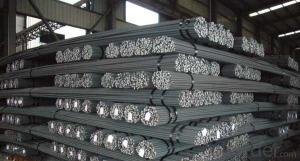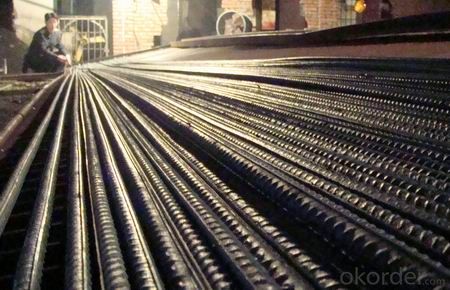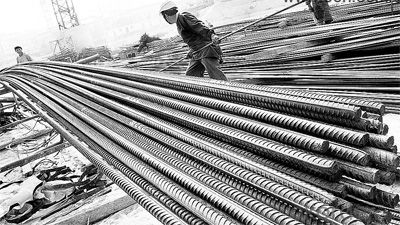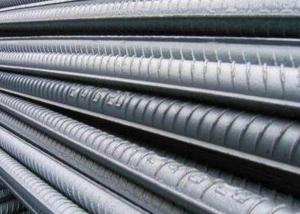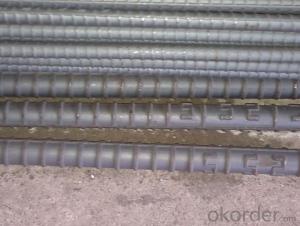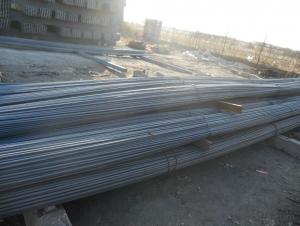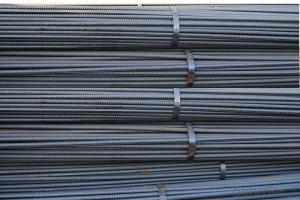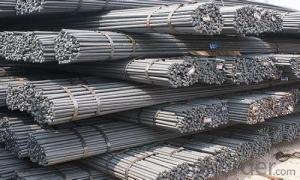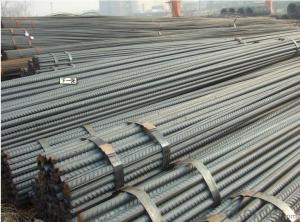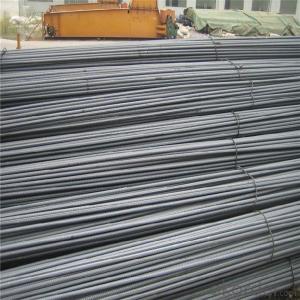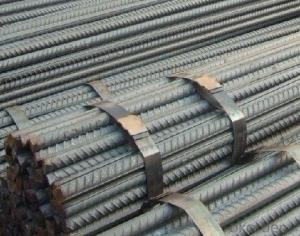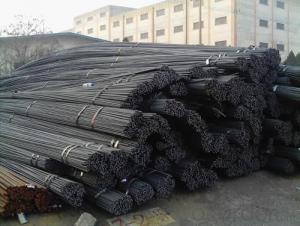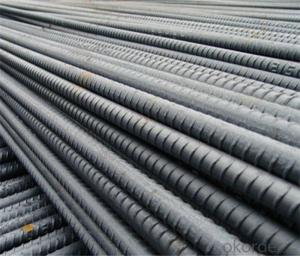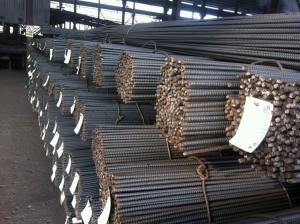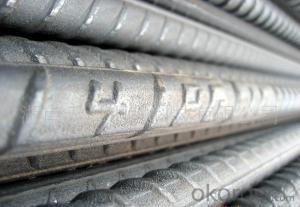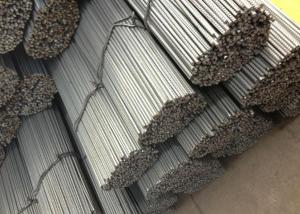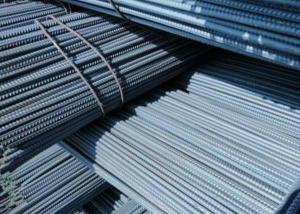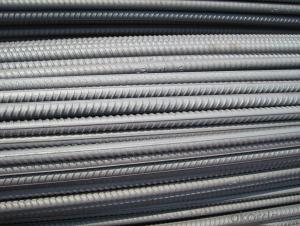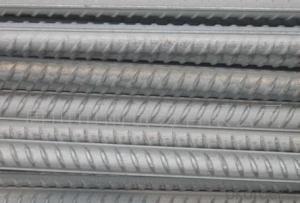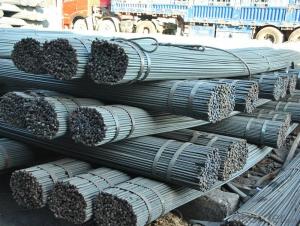50mm*15.42kg/m Deformed steel bar for construction
- Loading Port:
- Tianjin
- Payment Terms:
- TT or LC
- Min Order Qty:
- 25 m.t.
- Supply Capability:
- 100000 m.t./month
OKorder Service Pledge
OKorder Financial Service
You Might Also Like
Product Description:
OKorder is offering 50mm*15.42kg/m deformed steel bar for construction at great prices with worldwide shipping. Our supplier is a world-class manufacturer of steel, with our products utilized the world over. OKorder annually supplies products to European, North American and Asian markets. We provide quotations within 24 hours of receiving an inquiry and guarantee competitive prices.
Product Applications:
50mm*15.42kg/m Deformed steel bar are ideal for structural applications and are widely used in the construction of buildings and bridges, and the manufacturing, petrochemical, and transportation industries.
Product Advantages:
OKorder's Deformed steel bar are durable, strong, and resist corrosion.
Main Product Features:
· Premium quality
· Prompt delivery & seaworthy packing (30 days after receiving deposit)
· Corrosion resistance
· Can be recycled and reused
· Mill test certification
· Professional Service
· Competitive pricing
Product Specifications:
1.Detailed Product Description:
1.High Quality and the best service ;
2..Cheapest Price ;
3.many lines for making ;
4.verious size of Product.
2.Specifications:
Deformed bars/reinforced bars:
1.Material:GB--HRB400/HRB500 ; BS4449--460B/500B;
ASTM A615-Gr40/60 ; AS4671--500N/500E;
JISG3112--SD400 ; DIN488-1--BST500S;
KS-SD390.
2.Standard.:ASTM/JIS/DIN/BS/GB/KS.
3.Diameter:6-50mm.
The Specification of Deformed Steel Bars
| THEORETICAL WEIGHT INDEX | ||
| SIZE(mm) | CUT AREA(cm2) | THEORETICAL WEIGHT(kg/m) |
| 8 | 0.503 | 0.395 |
| 9 | 0.636 | 0.5 |
| 10 | 0.79 | 0.62 |
| 12 | 1.13 | 0.89 |
| 14 | 1.54 | 1.21 |
| 16 | 2.01 | 1.58 |
| 18 | 2.55 | 2 |
| 20 | 3.14 | 2.47 |
| 22 | 3.8 | 2.98 |
| 25 | 4.91 | 3.85 |
| 28 | 6.16 | 4.83 |
| 32 | 8.04 | 6.31 |
| Grade | Technical data of the original chemical composition(%) | ||||||||
| C | Mn | Si | S | P | B | ||||
| HRB335 | ≤ 0.25 | ≤ 1.60 | ≤ 0.80 | ≤ 0.045 | ≤ 0.045 | >0.0008 | |||
| Physics capability | |||||||||
| Yield Strength(N/cm 2 ) | Tensile Strength(N/cm 2 ) | Elongation (%) | |||||||
| ≥ 335 | ≥ 490 | ≥ 16 | |||||||
| Grade | Technical data of the original chemical composition (%) | |||||
| C | Mn | Si | S | P | V | |
| HRB400 | ≤0.25 | ≤1.60 | ≤ 0.80 | ≤ 0.045 | ≤ 0.045 | 0.04-0.12 |
| Physics capability | ||||||
| Yield Strength ( N/cm 2 ) | Tensile Strength ( N/cm 2 ) | Elongation (%) | ||||
| ≥ 400 | ≥570 | ≥ 14 | ||||
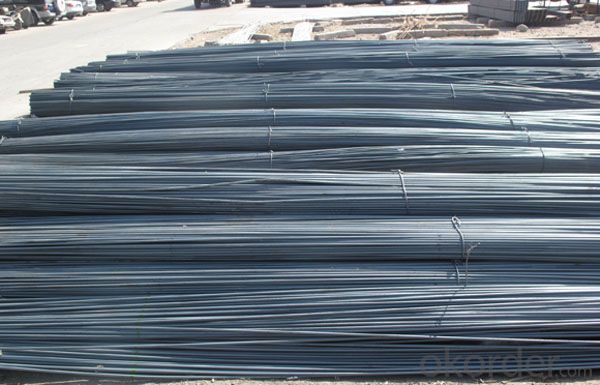
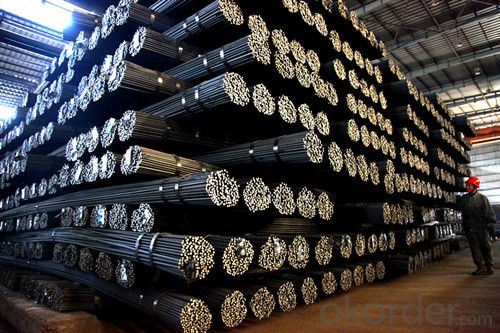
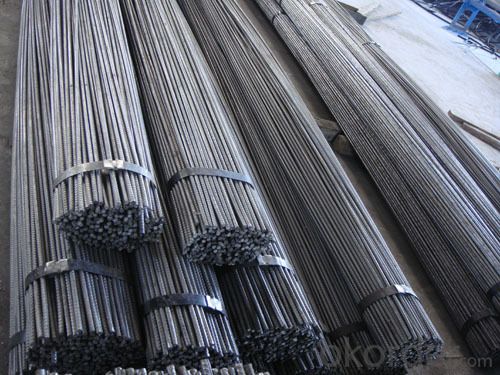
FAQ:
Q1: How do we guarantee the quality of our products?
A1: We have established an advanced quality management system which conducts strict quality tests at every step, from raw materials to the final product. At the same time, we provide extensive follow-up service assurances as required.
Q2: Can stainless steel rust?
A2: Stainless does not "rust" as you think of regular steel rusting with a red oxide on the surface that flakes off. If you see red rust it is probably due to some iron particles that have contaminated the surface of the stainless steel and it is these iron particles that are rusting. Look at the source of the rusting and see if you can remove it from the surface.
- Q: Can steel rebars be used in structures exposed to extreme temperatures?
- Yes, steel rebars can be used in structures exposed to extreme temperatures. Steel has high thermal conductivity, which allows it to transfer heat quickly, minimizing the risk of structural damage due to thermal expansion or contraction. However, it is essential to consider the specific temperature range and the potential impact on the structural integrity of the rebar. In extremely high temperatures, other materials or protective measures may be necessary to ensure the stability and safety of the structure.
- Q: How do steel rebars affect the fire resistance of a structure?
- The fire resistance of a structure can be affected both positively and negatively by steel rebars. On the positive side, steel rebars provide added strength and stability, enhancing the fire resistance. Having steel rebars in concrete structures can prevent collapse during a fire, giving occupants more time to evacuate and allowing emergency responders to control the situation. However, there are also drawbacks to steel rebars when it comes to fire resistance. Steel is a highly conductive material, meaning it transfers heat quickly. During a fire, the steel rebars can heat up and transfer the heat to the surrounding concrete, potentially weakening its structural integrity. This weakens the fire resistance of the structure. To counteract the negative effects of steel rebars on fire resistance, certain measures can be taken. One common approach is to apply fire-resistant coatings or wraps to the steel rebars. These coatings or wraps act as a barrier, slowing down the heat transfer from the steel to the concrete and enhancing fire resistance. Additionally, the size, spacing, and arrangement of steel rebars also play a role in fire resistance. Proper design and placement of rebars ensure that heat is distributed evenly, reducing the risk of localized weakening and structural failure. In conclusion, steel rebars have a significant impact on the fire resistance of a structure. While they improve overall strength and stability, they can also contribute to heat transfer and potential weakening. By implementing appropriate measures such as fire-resistant coatings and proper design, the negative effects of steel rebars on fire resistance can be minimized, ensuring the safety and integrity of the structure during a fire.
- Q: Are steel rebars suitable for use in extreme temperatures?
- Yes, steel rebars are suitable for use in extreme temperatures. Steel has excellent thermal properties and can withstand both high and low temperatures without significant loss in strength or structural integrity. This makes steel rebars a reliable choice for reinforcing concrete structures in extreme temperature conditions.
- Q: How are steel rebars protected against chemical attacks?
- Steel rebars are protected against chemical attacks through a process called corrosion protection. This involves using various techniques and materials to prevent the rebar from coming into contact with corrosive substances that can cause chemical attacks. One common method of protection is the use of protective coatings. This involves applying a layer of material, such as epoxy or zinc, onto the surface of the rebar. These coatings act as a barrier, preventing corrosive substances from reaching the steel surface. Additionally, these coatings can provide an extra layer of protection against moisture and other environmental factors that can contribute to corrosion. Another method of protection is the use of corrosion inhibitors. These are chemicals that can be added to the concrete mix or applied directly to the rebar. Corrosion inhibitors work by forming a protective layer on the surface of the steel, which inhibits the process of corrosion. These inhibitors can be organic or inorganic compounds and are designed to target specific types of corrosion mechanisms. In some cases, stainless steel rebars are used as a measure of protection against chemical attacks. Stainless steel has a higher resistance to corrosion compared to regular steel rebars. This is due to the presence of chromium, which forms a passive layer on the surface of the steel, protecting it from chemical reactions. Stainless steel rebars are often used in highly corrosive environments, such as marine structures or wastewater treatment plants. Regular maintenance and inspection are also crucial in protecting steel rebars against chemical attacks. Any signs of damage or corrosion should be addressed promptly. Regular cleaning and removal of any corrosive substances that accumulate on the rebars can also help prevent chemical attacks. Overall, a combination of protective coatings, corrosion inhibitors, stainless steel rebars, and regular maintenance is essential in protecting steel rebars against chemical attacks. These measures help to extend the lifespan of the rebars and ensure the structural integrity of concrete structures.
- Q: What are the factors that determine the spacing of steel rebars in a concrete structure?
- The spacing of steel rebars in a concrete structure is determined by several factors that ensure the structural integrity and strength of the concrete. These factors include: 1. Structural Design: The spacing of rebars is influenced by the structural design requirements and specifications of the concrete structure. Engineers consider the loads, stresses, and forces that the structure will experience and calculate the required reinforcement spacing accordingly. 2. Concrete Strength: The strength of the concrete being used in the structure is an essential factor in determining rebar spacing. Higher-strength concrete may require closer spacing of rebars to provide adequate reinforcement and prevent cracking or failure under load. 3. Rebar Diameter: The diameter of the steel rebars also plays a role in determining the spacing. Thicker or larger diameter rebars may require wider spacing, whereas thinner rebars typically require closer spacing to provide the desired reinforcement. 4. Bar Bending and Placing: The ease of bending and placing the rebars during construction is another important factor. The spacing is often determined by practical considerations, such as ensuring proper access for workers and equipment, and facilitating the concrete pouring process. 5. Environmental Factors: Environmental conditions, such as exposure to corrosive substances or extreme weather conditions, can influence the spacing of rebars. Closer spacing may be required in corrosive environments to provide additional protection against rust and deterioration. 6. Building Codes and Regulations: Building codes and regulations set by local authorities or relevant organizations also dictate the minimum requirements for rebar spacing in concrete structures. These codes ensure compliance with safety standards and provide guidelines for construction practices. Overall, the spacing of steel rebars in a concrete structure is a critical aspect of ensuring its strength, durability, and resilience. It is determined by a combination of structural design, concrete strength, rebar diameter, construction practicalities, environmental considerations, and adherence to building codes and regulations.
- Q: What is the process of bending steel rebars into shapes other than straight bars?
- The process of bending steel rebars into shapes other than straight bars involves several steps and techniques. Firstly, the rebars need to be measured and marked to indicate the desired bending points and angles. This is usually done using a measuring tape, a square, and a marker. Next, the rebars are secured in a bending machine or a manual bending tool. The bending machine consists of two main components - a bending head and a bending table. The rebars are placed on the bending table, and the bending head is adjusted to the desired angle and position. Once the rebars are securely positioned, the bending process begins. For smaller rebars, manual tools such as a rebar bender or a rebar cutter can be used. These tools allow the worker to apply force and bend the steel rebar to the desired shape. For larger rebars or complex shapes, a hydraulic bending machine is often employed. This machine uses hydraulic pressure to bend the rebars, allowing for greater precision and control. The operator can adjust the angle and radius of the bend to achieve the desired shape. During the bending process, it is important to ensure that the rebars are not overstressed or damaged. Excessive bending can weaken the rebars and compromise their structural integrity. Therefore, it is crucial to follow the bending specifications and guidelines provided by engineers and construction standards. After the rebars have been bent to the desired shape, they are typically inspected for any defects or imperfections. This is done to ensure that the rebars meet the required standards and can be safely used in construction projects. In conclusion, the process of bending steel rebars into shapes other than straight bars involves measuring and marking, securing the rebars in a bending machine, applying force or hydraulic pressure to bend the rebars, and inspecting the final product for quality assurance. This process requires precision, skill, and adherence to safety guidelines to ensure the rebars can withstand the intended structural loads.
- Q: What is the role of steel rebars in maintaining structural integrity?
- Steel rebars play a crucial role in maintaining structural integrity by reinforcing and strengthening concrete structures. They provide tensile strength to resist cracking, bending, and shearing forces, enhancing the overall stability and durability of buildings, bridges, and other infrastructure.
- Q: Can steel rebars be used in modular construction?
- Yes, steel rebars can be used in modular construction. Steel rebars are commonly used as reinforcement in concrete structures, and since modular construction often involves the use of concrete elements, rebars can be incorporated to enhance the structural integrity of the modules.
- Q: What is the role of steel rebars in ensuring structural stability?
- In various construction projects, steel rebars are essential for maintaining structural stability. These reinforced bars are primarily utilized to strengthen concrete structures, like buildings, bridges, and highways, by providing additional tensile strength. Concrete is a highly versatile material capable of effectively withstanding compressive forces. However, its resistance to tensile forces is limited. This is where steel rebars come into play. By reinforcing concrete with steel rebars, the resulting composite material can effectively resist both compressive and tensile forces, thereby enhancing its overall structural stability. Under loads such as the weight of the structure or external forces like wind or seismic activity, concrete experiences tensile stresses. Without reinforcement, these tensile stresses can lead to cracks and ultimately result in structural failure. Thanks to their high ductility and tensile strength, steel rebars can absorb and distribute these tensile forces throughout the structure. To ensure optimal reinforcement, the placement and arrangement of steel rebars are carefully designed. Typically, they are embedded within the concrete in a grid-like pattern, forming a reinforced concrete matrix. This matrix strengthens the structure and prevents cracks from propagating, thereby effectively increasing its load-bearing capacity and durability. Furthermore, steel rebars also play a crucial role in maintaining the structural integrity of concrete structures over time. They help combat the effects of shrinkage, expansion, and temperature fluctuations that can lead to cracking. By providing a strong and flexible reinforcement system, steel rebars minimize the risks of structural damage and ensure the long-term stability of the construction. In summary, the role of steel rebars in ensuring structural stability can be summarized as follows: increasing the tensile strength of concrete, preventing cracks and structural failure, enhancing load-bearing capacity, and promoting long-term durability. By reinforcing concrete structures with steel rebars, engineers can create resilient and safe constructions capable of withstanding various forces and maintaining their integrity for decades.
- Q: How are steel rebars used in road and pavement construction?
- Steel rebars are used in road and pavement construction to provide reinforcement and enhance the structural integrity of the concrete. They are placed within the concrete mixture to withstand the tensile forces and prevent cracks or failures in the road or pavement, ensuring durability and longevity of the infrastructure.
Send your message to us
50mm*15.42kg/m Deformed steel bar for construction
- Loading Port:
- Tianjin
- Payment Terms:
- TT or LC
- Min Order Qty:
- 25 m.t.
- Supply Capability:
- 100000 m.t./month
OKorder Service Pledge
OKorder Financial Service
Similar products
Hot products
Hot Searches
Related keywords
